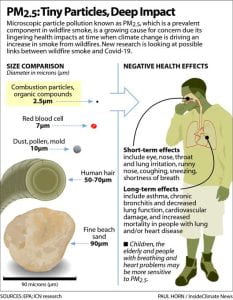Resource: Ben Garver Berkshire Eagle June 7 2023
If you went outside last week, you likely noticed the smog enveloping Pittsfield. The smog persisted for a few days and made the air smell like smoke. This was caused by particulate matter, or PM 2.5. This particulate matter is a mixture of various chemicals and some of them are harmful. These were carried here by wind from the ongoing Canada forest fires. Canada is experiencing an increasingly high volume of forest fires this year, and it’s expected to get worse. It’s believed that these fires were the result of a dry season and more frequent lightning strikes*. While the Pittsfield smog has dispersed for now, there’s a high chance that we’re going to encounter more air pollution as the forest fires continue to burn.
Fires in Quebec
Resource: https://globalnews.ca/news/9762553/canada-wildfires-rain-air-quality/
PM 2.5 is something we encounter in our everyday lives, though not in levels as high as last week. Cars and industry release a large amount of PM 2.5, but not enough for our air quality to be considered dangerous. However, with the forest fires, we reached 190 on the Air Quality Index, which we usually score 30 on. The more PM 2.5 in the air, the higher the number goes. Readings under 50 are considered healthy and above 150 is considered unhealthy**. This can cause health issues in the short and long term. In the short term, it can cause discomfort, coughing and shortness of breath. In the long term, it can cause respiratory and cardiovascular damage.
However, humans aren’t the only organisms affected by wildfire pollution. Many of the effects on humans are also applicable to animals. Respiratory and cardiovascular problems can be found in animals that suffer long-term from PM 2.5 exposure. It’s even more damaging to small animals, who can have a spike in mortality rates when exposed to PM 2.5***.
The PM 2.5 is also being deposited into our soil and water through acid rain. When it rains, most of the pollutants in the air are captured by the rain and then deposited in the soil and into natural bodies of water. This can increase our water’s acidity and the number of carcinogens present. The quality of water has an effect on humans, although the impact is larger on ecosystems and animals, who rely on the unfiltered water to survive****.
Resource:
It is likely that we’ll see more smog in the immediate future, so it’s important to know how to stay safe through this. You can check our air quality on Airnow.gov. When the levels of pollutants rise to unhealthy levels, try to stay indoors, wear a mask if you have to go outside, and avoid outdoor physical activity as much as possible. If you can filter the air coming into your house that would be ideal. Close your windows and use fans or air conditioners with filters. Trees and plants will also filter the air so if you have houseplants that’s even better. If you have pets or livestock, it can be beneficial to have emergency plans for when this happens again. Consider making plans to safeguard young children, seniors, and immuno-compromised individuals.
Although, this disaster can serve as a wake-up call to a lot of us. Third world countries are being affected by environmental issues already; some countries have instituted successful programs we could learn from. Hopefully, citizens will advocate for programs addressing global warming, and push for much-needed accountability. Can we move forward upholding and enforcing environmental laws that are already in place?
https://www.brainyquote.com/quotes/margaret_mead_100502
Contributors:
Logan Osorio
Logan Sargent
Works Cited:
***https://iopscience.iop.org/article/10.1088/1748-9326/ac30f6/meta
****https://www.epa.gov/acidrain/effects-acid-rain




